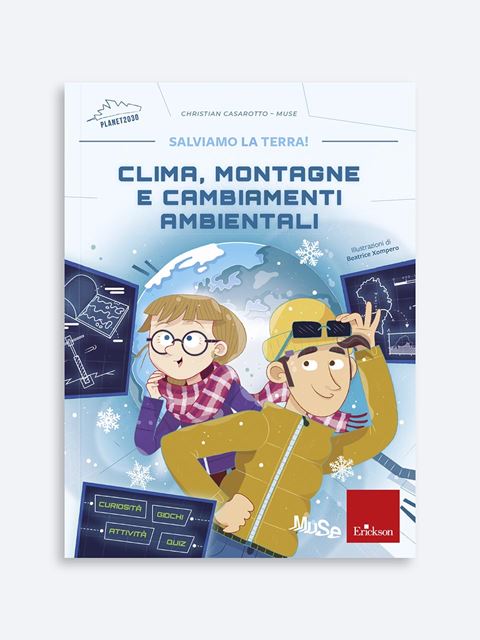 EN
EN
 PT
PT


THE SERIES
The reference framework for the new series of workbooks, Let’s Save the Earth, is that of Environmental Sustainability promoted by the United Nations 2030 Agenda.
The series offers 5 informative, colourful and engaging workbooks, full of activities and exercises, created in collaboration with MUSE – The Trento Science Museum, to accompany boys and girls on a journey of discovery of the environmental challenges of our century.
Young readers, accompanied by the expert scientists of Planet 2030, a super technological ark with zero impact, will learn about the phenomena that cause the alteration of our planet’s ecosystems and train their critical thinking skills to become promoters of conscious change and succeed in achieving important future goals in the field of environmental sustainability.
STRUCTURE AND CONTENTS
Each notebook in the series includes:

Initial comic and character guide

Narration of the contents

Activities and exercises

Final review quiz

Final stickers’ collection map

Solutions available online
THE VOLUMES IN THE SERIES
The footprint of man from prehistoric times to the present day
Help the staff of expert scientists of Planet 2030 save our beautiful Planet by verifying the impact produced by mankind from prehistoric times to the present day.

The topics in this notebook are:
Leaf through some selected pages from the book that have been translated into English to facilitate your evaluation:
Habitats, ecosystems and biodiversity protection
Help the staff of expert scientists of Planet 2030 save our beautiful Planet: get to know ecosystems and the immense variety of living organisms that populate them.

The topics in this notebook are:
Leaf through some selected pages from the book that have been translated into English to facilitate your evaluation:
Climate, mountains and environmental changes
Let’s help the expert scientists of Planet 2030 save our beautiful planet by studying how glaciers work, their importance for the earth’s balance, and for man, and their fragility.

The topics in this notebook are:
Leaf through some selected pages from the book that have been translated into English to facilitate your evaluation:
THE AUTHORS
Elisabetta Flor manages archeology at MUSE – The Trento Science Museum. Her passion for the oldest part of human history has led her to specialize, in particular, on the study of the population of the Alps during the Mesolithic. Today she manages scientific dissemination, such as exhibitions, the organization of events and the planning of activities for schools.
Alessandra Pallaveri is a zoologist and cultural mediator at MUSE – The Trento Science Museum. Her passion for nature and animals has led her to graduate in Natural Sciences and specialize in zoology, in particular on animal behavior. In the museum she deals with the planning of educational activities, events for the public, communication and setting up of exhibitions, all with a zoological theme.